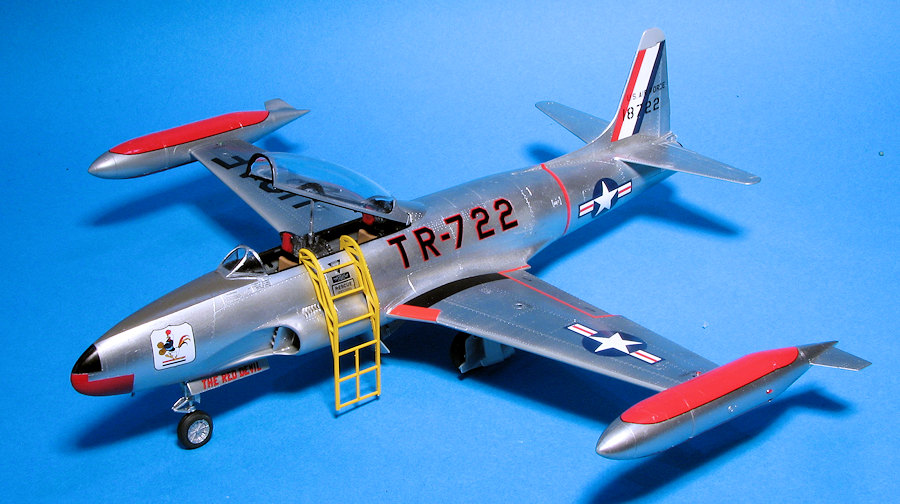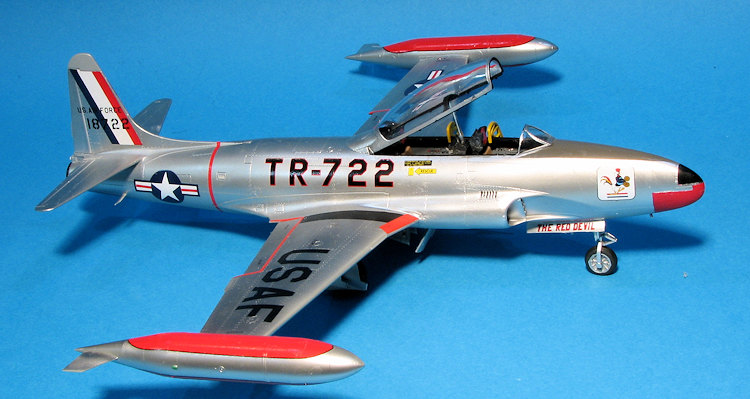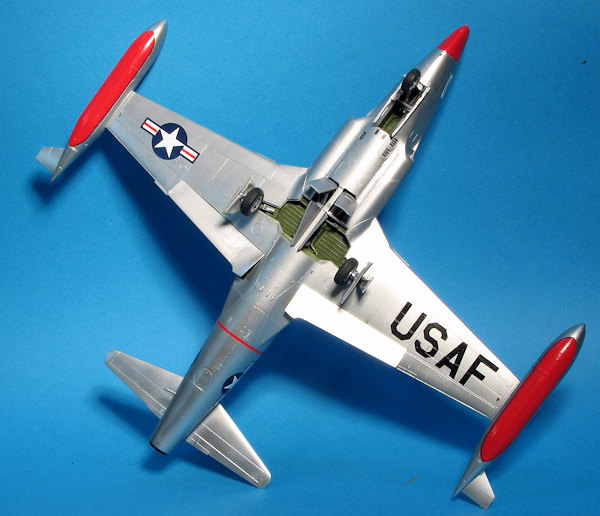
GWH 1/48 T-33 Shooting Star 'Early Version'
| KIT #: | L4819 |
| PRICE: | $ |
| DECALS: | Three options |
| REVIEWER: | Scott Van Aken |
| NOTES: | New tool kit (2016) |

| HISTORY |
 The Lockheed T-33 Shooting Star is an American-built jet trainer aircraft. It was produced by Lockheed and made its first flight in 1948, piloted by Tony LeVier. The T-33 was developed from the Lockheed P-80/F-80 starting as TP-80C/TF-80C in development, then designated T-33A. It was used by the U.S. Navy initially as TO-2 then TV-2, and after 1962, T-33B. While there are no more military T-33s still in active service, the type is very popular with the jet warbird crowd. Many T-33s spent over 40 years on active service before being retired.
The Lockheed T-33 Shooting Star is an American-built jet trainer aircraft. It was produced by Lockheed and made its first flight in 1948, piloted by Tony LeVier. The T-33 was developed from the Lockheed P-80/F-80 starting as TP-80C/TF-80C in development, then designated T-33A. It was used by the U.S. Navy initially as TO-2 then TV-2, and after 1962, T-33B. While there are no more military T-33s still in active service, the type is very popular with the jet warbird crowd. Many T-33s spent over 40 years on active service before being retired.
| THE KIT |
The T-33 has always been a somewhat popular subject. Regarding 1/48, in the 1960s we had one from Hawk that was reissued several times by Testors. Twenty years or so after that we had a much nicer version from Hobbycraft that was reboxed by Academy. Nice as it was it was still lacking in the detail we expect today, though it did not have the big shape issues of the Hawk kit. Now, GWH has produced a thoroughly modern mold for the T-33 fan.
If you have seen any GWH kit you know that the detailing is excellent. Nicely engraved panel lines and rivet detail, though nothing overboard. I know that some modelers don't like engraved rivets, but they are part and parcel of modern aircraft kits. Most of us do not mind at all. All the parts save the clear bits are in GW H's light grey plastic. Inspection of the parts showed no ejector pin marks that would be visible save perhaps one in the center piece of the main gear well. Gear doors and the face of the inside intake showed some light sink areas that would have to be dealt with, but nothing major.
H's light grey plastic. Inspection of the parts showed no ejector pin marks that would be visible save perhaps one in the center piece of the main gear well. Gear doors and the face of the inside intake showed some light sink areas that would have to be dealt with, but nothing major.
Reading through the instructions I saw a few areas that made me raise my eyebrows. One is that one was supposed to completely build up the landing gear prior to installing the gear wells into the appropriate areas. This is, for me, just asking to break bits. It looks like the landing gear can be installed after painting and that is what I'll do. Another is that all the gear doors, and this includes the speedbrakes, are molded shut as a single piece, requiring the builder to cut them open. I've not seen this on a modern kit in many years. I also question the order of parts installation in steps 3 and 4 as it seems they want the fuselage together before adding the inner intake pieces. When you see it, you'll see what I mean. Most modelers will be able to work around this without any issues. As clarification, these are not molded shut on the lower wing, but as a separate piece.
The kit's cockpit is really nicely done. The one piece tub has raised side console detail, though one could put decals on them if one so wishes. The seats are each seven pieces and while there is no belt detail, they look very nice. Something new to me was that the instrument panels are in two pieces. One is to trap an instrument decal between the two pieces. This will allow one to prepaint the panel and then have glossy instrument faces. It will be interesting to see how this works out. Rudder pedals attach to the back of the instrument panels.
You are provided with pretty long intakes and while there is no engine compressor face, they are long enough to make it believable. There are a few ejector pin marks on the inside of the outer intake pieces so you may want to deal with those. There is a single exhaust tube that has a compressor piece attached to the back. The instructions show the nose gear well attached to the underside of the cockpit and an area to put weight, but no amount is suggested.
 Wings are a single lower piece with two upper ones. To pose the flaps lowered, each lower wing side gets four actuating pieces. The main gear well is a single piece with a separate piece between the wells. There are holes in the lower wings for pylons, but none are supplied. I should also mention that the nose guns are plated over.
Wings are a single lower piece with two upper ones. To pose the flaps lowered, each lower wing side gets four actuating pieces. The main gear well is a single piece with a separate piece between the wells. There are holes in the lower wings for pylons, but none are supplied. I should also mention that the nose guns are plated over.
All the control surfaces are separate and while one almost never saw the flight control surfaces any way but neutral, the speed brakes were often down and one could also find the flaps lowered while on the ramp. Landing gear is nicely detailed and as I mentioned, the instructions want these installed rather early. I suggest leaving them off until later if you can. The underside of the aircraft has a number of small pieces that fit there including four little bumps in between the flaps. I have no idea what these are. Perhaps something to do with air flow. There is an interior piece for the canopy and the instructions show this in the open position. A nice ladder is provided as a single piece so no fiddly steps, though one will have some quality seam removal time ahead of them.
The instructions for the kit are in three different sheets. One is a map-like fold out with the construction steps. I mentioned that some of the sequences did not seem to follow a logical progression so keep that in mind. All the color call-outs are with MIG or Gunze paints. The reference diagram for these paints is on another large sheet that includes the sprues layout and the aircraft history. Then there is the full color painting diagram. All the planes are shown in a base color of flat aluminum. The box art plane is with the 78th FIS in 1957. Then there is a Bundeswaffe plane with a tulip nose from JG 71 in 1961. The rear fuselage and outside of the tanks are shown as being red, but looking at period photos, I'm willing to bet they are da-glo. Finally an Italian version with a radar calibration unit. Most of this airframe is the standard orange in which Italian trainers were painted for years. Having the center of the aircraft in unpainted metal makes for an interesting scheme and a bit of a masking challenge. The large decal sheet is nicely printed and should work just fine as I've had positive experiences with GWH markings.
| CONSTRUCTION |
 For this one, the first step was to do some prepainting. I painted all the wheel wells with FS 34097 as that seems close to the dark chromate green used on planes around this time. I also painted the cockpit with FS 36231 dark gull grey. Both are Testors enamels. The seats were then assembled and painted flat black. Note that the lower piece below the seat proper should only be attached at the back or you won't get the side pieces to fit properly. I left the cushions off to make it easier to paint them.
For this one, the first step was to do some prepainting. I painted all the wheel wells with FS 34097 as that seems close to the dark chromate green used on planes around this time. I also painted the cockpit with FS 36231 dark gull grey. Both are Testors enamels. The seats were then assembled and painted flat black. Note that the lower piece below the seat proper should only be attached at the back or you won't get the side pieces to fit properly. I left the cushions off to make it easier to paint them. 
| COLORS & MARKINGS |
 the later tip tanks on one of the options. I first filled the various wells with silly putty and taped over the cockpit after attaching the masked windscreen. I also taped over the flap wells and the exhaust.
the later tip tanks on one of the options. I first filled the various wells with silly putty and taped over the cockpit after attaching the masked windscreen. I also taped over the flap wells and the exhaust.  ecal is ready to remove from the backing. Note that the flap warning decals are meant for when the flaps are up. It would have been nice to have small slivers of decal for the upper flaps themselves, but there it is. At least the sheet included the wing walk areas.
ecal is ready to remove from the backing. Note that the flap warning decals are meant for when the flaps are up. It would have been nice to have small slivers of decal for the upper flaps themselves, but there it is. At least the sheet included the wing walk areas. | CONCLUSIONS |
 Overall I'm quite pleased with this one. There are a few areas where you have to pay attention to things while you build, but overall, GWH has done a fine job engineering this one. It builds without the headaches of some kits and definitely puts the Hobbycraft/Academy T-33 into the second tier category. If I had to fuss about something, it would be having to cut apart the gear doors, as well as the iffy fit of the nose cap. I'm still not sure why model companies want you to build up the landing gear before doing major air frame assembly, but that sort of thing seems a lot more prevalent than it was.
Overall I'm quite pleased with this one. There are a few areas where you have to pay attention to things while you build, but overall, GWH has done a fine job engineering this one. It builds without the headaches of some kits and definitely puts the Hobbycraft/Academy T-33 into the second tier category. If I had to fuss about something, it would be having to cut apart the gear doors, as well as the iffy fit of the nose cap. I'm still not sure why model companies want you to build up the landing gear before doing major air frame assembly, but that sort of thing seems a lot more prevalent than it was.
Those small quibbles aside, this is a great kit. I fully plan on doing another when these reach the dealer's shelves and if you are a T-33 fan, I'm thinking you will want at least one as well. Now the aftermarket folks can help us out with replacement tires and perhaps some seats with molded on harness as well as a decal sheet or two. Pick this one up when you see it. You'll be glad you did.
| REFERENCES |
http://en.wikipedia.org/wiki/T-33A_Shooting_Star
10 June 2016 Copyright ModelingMadness.com Thanks to Great Wall Hobbies for the preview kit. These should be on store shelves soon. If you would like your product reviewed fairly and fairly quickly, please contactthe editor or see other details in the